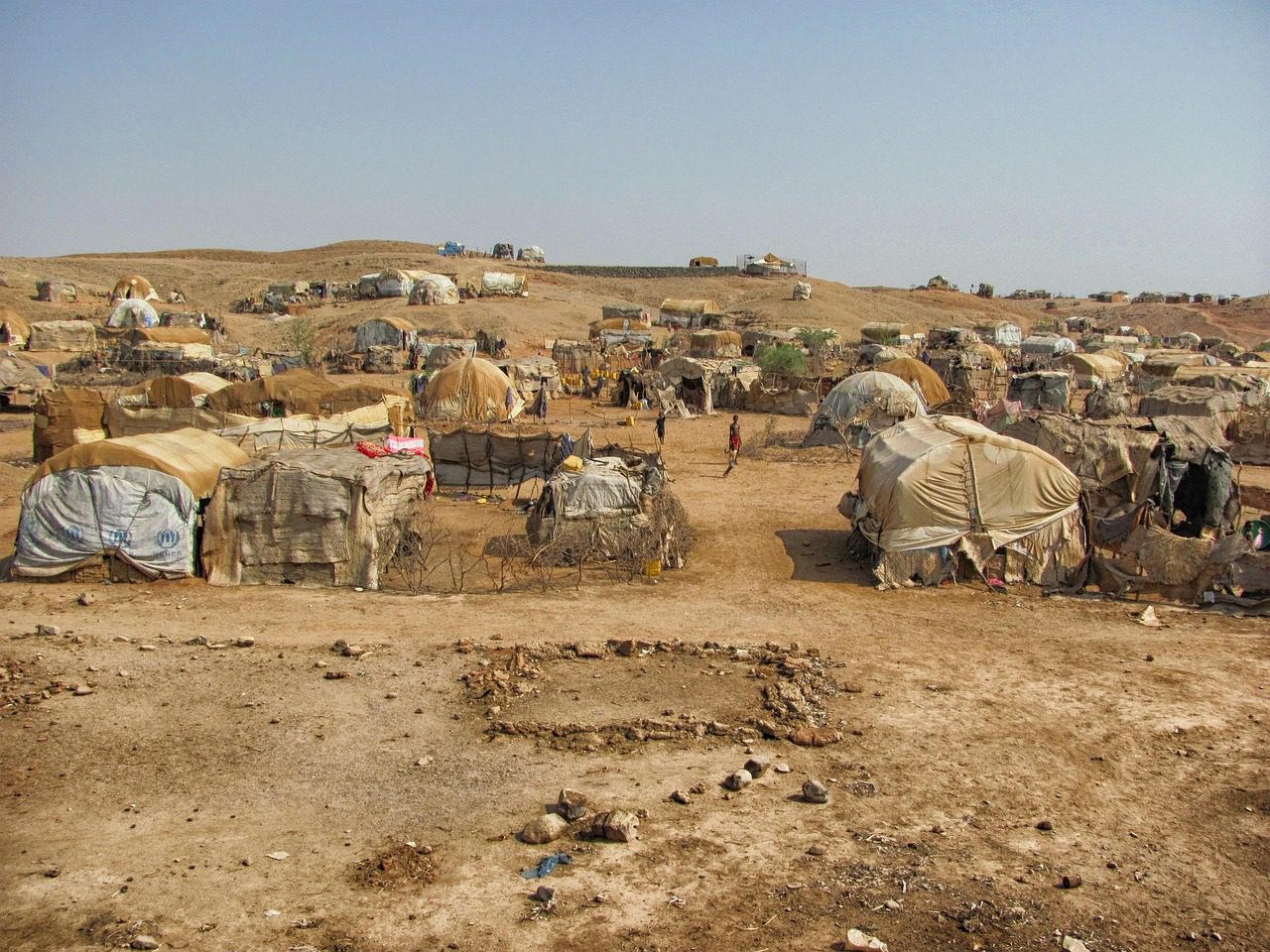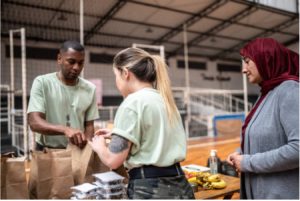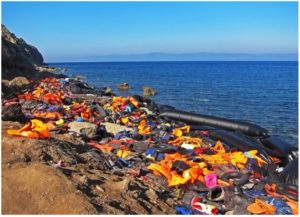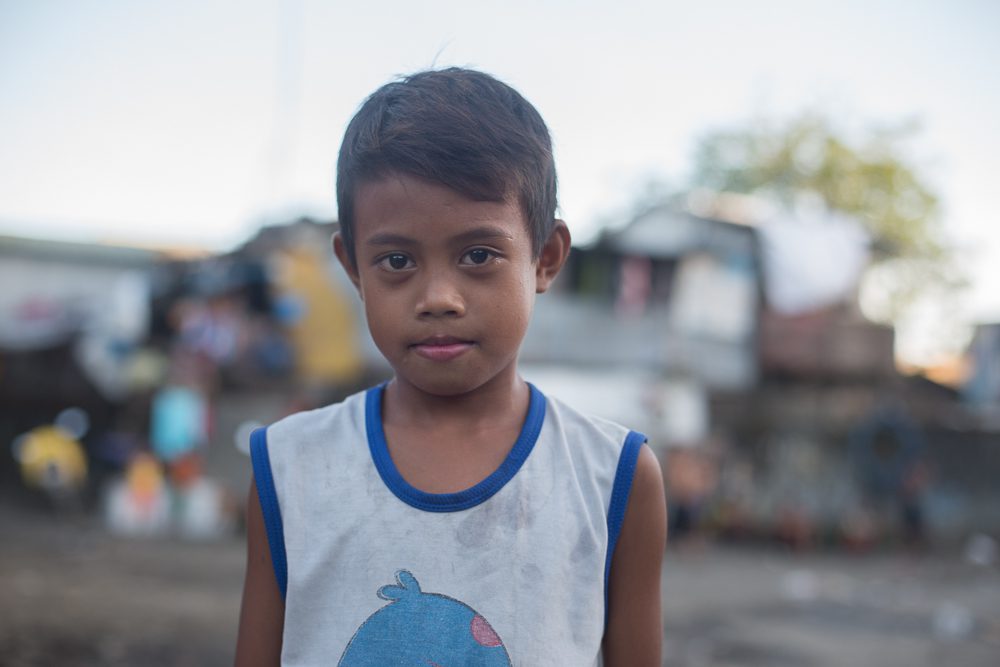
It is a commonly accepted fact that war and conflict perpetuate the displacement and mass movements of populations subjected to its violence. The term refugee’s first noted use was in 17th century France to refer to the Huguenots – French protestants who fled to surrounding nations when their religious liberty was threatened with violence – and has been an unfortunate recurrent staple in both academic and media discourses ever since[i].
Despite its common usage, many people often use the terms refugee and migrant interchangeably – a mishap heavily utilised in the UK Brexit campaign in 2016. However, the terms denote two different situations, and it is important to distinguish between the two. Migrants are defined as those who choose to leave their homes; refugees, on the other hand, are forced by the threat of persecution or violence.
Poverty has become a well-known, often long-term outcome of forced displacement. Whether this is historical or contemporary, refugees are forced to deal with hardships in both living standards and social exclusion when fleeing conflict. Despite some states having asylum and social policies for refugees, a growing Western shift towards right-wing social views and the adoption of isolationist national policies on migration have had detrimental effects on the living standards and well-being of refugee populations living in new countries in search of greater stability and welfare. Those most susceptible to these issues are children.
The Issues at a Glance
Poverty is multifaceted by nature and there is a myriad of issues that stem from its base that refugees face, particularly when living in unstable, makeshift refugee camps. Securing necessities such as medicine, fuel, shelter, food, and water is a constant struggle for displaced families, especially given that many of those fleeing conflicts lack the economic funds required to obtain these resources. The issue is only worsened when families are split up or children are orphaned by war – there are over 170,000 unaccompanied and forcibly displaced children worldwide today[ii]. The lack of these necessities further impacts the cognitive and psychological welfare of children which can, and does, stunt both physical and cognitive growth in the long term.
Whilst these are major issues that must be addressed if we are to combat the levels of poverty refugees face, they are (despite their monetary derivative) somewhat controllable amenities. By this, I do not mean that they are readily available – as they are not – and to say so would disregard the hardships refugees face trying to acquire them and their importance for survival. Rather, they are things that can be sought with the right resources. However, as stated, most refugees do not possess the economic or social capital for this. Whilst some may work jobs (which are often poor-paying, insecure 0-hour contracts), many instead become heavily reliant on foreign humanitarian aid – especially those in camps.
Humanitarian organisations such as The Red Cross and Lighthouse Relief, particularly UNICEF for children, send aid packages to refugees worldwide to help address some of the issues they face, primarily in the form of food packages and hygiene toiletries. Children are often the ones to receive a large proportion of this aid which allows them to secure the basic necessities for survival – although this is not always the case.
But, whilst humanitarian aid may offer some relief in certain instances, it struggles to meet the needs of all those who require it and is not an answer for all the issues that poverty presents. Children living in foreign countries often struggle with sociability because of language barriers and a difference in cultural hegemony. In other words, they lack the social skills required to socialise in that specific region as it is often different from what they are used to at home. This in turn means they lack the necessary social interactions required for social growth which only serves to isolate them from the wider society in which they now reside. This can lead to the creation of isolationist diasporic refugee communities that live on the outskirts of their new host country, limiting a child’s capacity for growth.
Palestinian displacement in Lebanon
The civil unrest in Israel-Palestine has left the eastern coastal plain of the Middle East in conflict since the state’s partition in 1948. It has created displacement of refugees on a massively unprecedented scale. A large proportion of those forced from their homes in the West Bank have fled to neighbouring Lebanon. An estimated 300,000 Palestinian refugees are currently living in Lebanon[iii]. Of these 300,000, approximately 93% are living in poverty[iv]. The situation is the same for those in Jordan and Syria.
The Israeli state ‘opposes their return to Israel as it would alter the country’s Jewish character whilst the Lebanese state opposes their implantation in Lebanon’[v] as their practice of largely Sunni Islam is perceived to threaten the already fragile coalition of constituencies governing the country. The result leaves Palestinian refugees in a limbo state, living in camps, struggling to obtain necessities, and existing as outsiders not only to Palestine but to their new hosts too. Living in such ostracising conditions can and does have negative effects on the levels of well-being and esteem experienced by those on the outskirts of society.
When it comes to basic needs, food insecurity is strife amongst the children of these populations with 23.8% of those under 5 being malnourished leading to long-term growth stunting[vi] and a further 25% prevalence of anaemia. Disease is a common issue produced mainly by inadequate housing. Cholera and cardiovascular disease are highly prevalent among Palestinian children because of indoor pollutants, infestation, mould, and dampness in the home – issues impossible to deal with when you are not formally recognised by the state in which you reside.
Many children do not have any form of formal education – an issue largely exacerbated by lacking electricity. In the Lebanon camps, households are only supplied with 2 hours of government-regulated electricity a day meaning children have little else to do but hang around in the alleys between buildings in camps to play and wander, exposing them to dangers of abuse, abduction, and trafficking – an issue that particularly affects young girls.
The conditions in which these children live do not serve to better their position in society since leaving the conflict zones of the West Bank and Gaza. They place them at a disadvantage by removing their opportunities for socialisation with wider social actors which only condemns them to live at arm’s length from their native Lebanese peers, whether that be in school or work or play.
Whilst there is still a great deal to be done, multiple agencies are working to improve the position and livelihoods of young Palestinian refugees. Last year, ANERA helped 1,357 Palestinian refugee graduates in Lebanon get jobs in the vocational sector after leaving one of their multiple schools in the region[vii]. The skills they use not only benefit them immediately but also help the wider refugee community in which they live by injecting money into the area to fund development. Furthermore, future generations will benefit from the skills taught to them by employed young adults. Having a job also lessens the reliance on foreign aid and helps to develop an individual’s cultural capital by exposing them to wider social inclusion through work, which can, in turn, reduce the stigmatisation of refugee populations in host nations.
The biggest humanitarian force in the region is the United Nations Relief and Works Agency for Palestinian Refugees (UNRWA). Established in 1949 following the first Arab-Israeli conflict post-partition, the organisation currently provides education to over 39,000 Palestinian child refugees living in the 12 camps of southern Lebanon – a number which rises to 545,000 students when incorporating those in Jordan, Syria, Turkey and more[viii]. A similar picture is painted about healthcare with 550,000 registered patients each year visiting one of 27 different healthcare clinics in southern Lebanon[ix] helping to combat the issues of disease that too commonly prevent children from living until adulthood. The organisation is currently in the process of reforming its healthcare policy to bring a new holistic family health team approach to better suit the needs of refugee populations.
However, the issue is that the United Nations general assembly has had to continuously renew the UNRWA’s mandate since its establishment in the absence of a solution to the refugee crisis that Palestine’s population has faced for decades now. Whilst it is the case that some have gained valuable skills in education and work, there are still many others who have not and continue to live in poor, unsafe conditions ostracised by wider society. And whilst the work that NGOs do is pivotal to Palestinian society’s survival and upkeep, its efforts are negligible until such a time that a long-lasting peace can be brokered and enforced – something that has had little success thus far.
The Syrian Refugee Crisis
Probably the most well-known example of modern displacement of refugees lies just north of Israel/Palestine. In the 10 years following the start of the Syrian civil conflict in 2011, over half the country’s population have been displaced across 130 countries around the world – 70% of whom are living in poverty producing what the UN High Commissioner for Refugees, Filippo Grandi, has called ‘the largest refugee crisis in modern times’[x].
In September last year, UNICEF released a report noting that there are currently 5,900,000 Syrian children living as refugees who need support[xi]. Like the Palestinian populations mentioned above, many Syrian refugees reside in large camps riddled with incidents of poverty. Lacking education, work, poor health, and security are just some of the similarities in issues that Syrian refugees face. What tends to go under the radar most often in the discussion of Syrian displacement is the social and psychological influence that life as a refugee has on the children who flee.
Notions of national pride are cracking under the weight of a refugee crisis that is still very much ongoing. This is particularly true for young men and boys living as refugees from Syria, especially as Syrian nationalism is allied strongly with traditional perceptions of masculinity to fight for the ‘fatherland’[xii] – a somewhat colloquial spin on the commonly used phrase ‘motherland.’ Syrian boys have struggled to adjust their ideas of manhood and masculinity when living as a refugee as their function of masculinity has been challenged by western ideals on changing gender norms[xiii] which has caused a rise in anxiety and depression among young male refugees.
Similarly, living as a refugee, especially for long periods, can, and does, influence and form a child’s perception of both themselves and their country. A recent report found that a group of children who have been displaced and are living in makeshift refuges on the outskirts of Idlib in north-western Syria have been struggling to identify with their cultural heritage after 10 years of conflict has thwarted their sense of home[xiv]. Despite the country’s rich heritage, Syrian children today do not see their war-scarred country as holding any future opportunities for them and most would rather move elsewhere in the hopes of better education, well-being and standard of living. The desired location for most is in Europe.
But the past 10 years have seen Syrians in Europe face xenophobia and hate crime at an alarmingly high rate. Largely a result of Western political and media representations, some young Syrians have been victims of crimes by those native to the host society. In August of 2021, Turkish Nationalists gathered near an enclave of Syrian refugees and began to attack their homes and businesses[xv]. In the UK in 2018, a 15-year-old male Syrian student was attacked by his peers after school whilst a young Syrian girl was pushed in front of a train in North London[xvi]. Many incidents go unreported to the police as they feel they either won’t be believed or fear that cultural and language barriers prevent them from seeking help.
Even applying for asylum can be a long and arduous task. For refugees in the UK to gain access to healthcare, housing, and many other necessities for life, they need to have applied for asylum or pre-settled status – a task that can be complex, especially when those applying are young adults and families with children who do not speak English. And whilst you can still reside in the UK whilst the application pends, you are still not formally recognised by the state as having asylum and as such do not reap the benefits of stuff, often leaving families in poor financial and housing situations. However, various institutions can offer support in this process; Migrant Help UK, Refugee Council and Shelter all have services dedicated to the support of refugees applying for asylum.
Once asylum is granted the benefits for refugee populations can be massive, especially as some refugees (particularly those with children as they are considered most vulnerable) are eligible for the resettlement scheme. In 2022 alone, 1054 Syrian refugees were resettled in the UK[xvii], 52% of the total scheme.
Of course, it is not always as simple as this and many Syrian children travelling alone in particular do not have the means or skills to make it to the UK and thus end up in insecure accommodations or camps across Europe. The bulk of these exist in Turkey, an area recently struck by an immense earthquake, producing further issues for survival as a refugee. The most well-known Syrian refugee camp, however, exists in Calais, northern France.
The ‘Calais Jungle’ represents a severe example of what Syrian children face when living in refugee camps both alone and with their families. Hunger is commonplace with each person being given only one meal a day. Any food kept by those in the camp cannot be stored effectively as there is minimal electricity and infrastructure, leaving food and water to be contaminated by the high levels of pathogenic bacteria present causing vomiting and diarrhoea.
Hygiene is poor with 1 toilet per 75 refugees, more than three times the acceptable standard recommended by the UNHCR. Furthermore, since there are no effective means to wash clothes or bedding there are mass infestations of scabies and lice throughout the camp.
These issues are concerning for children’s physical health, but it is again important to look at how this burden has detrimental impacts on mental health and how the perception of oneself may change in light of how others perceive you – a notion particularly prominent in European media. Refugees are continuously labelled as the scapegoat for issues in Europe by Western media outlets; a representation that impacts on the well-being and self-esteem of refugee children by reaffirming them as a cultural other[xviii]; as different.
Living with this feeling of otherness only serves to worsen the issues of ongoing psychological trauma, anxiety and depression – which are all common mental health concerns that refugee children in the Calais jungle (and other camps) live with. For Syrian children, these stem from both the pre-displacement experiences of war and conflict in Syria; and the post-refugee life experiences resulting from the separation of families, difficulties in the asylum-seeking procedures, social exclusion and more[xix] in their new host nation (France in this instance).
As such, the concerns are not simply for the immediate impacts of these psychological issues but also the long-term damage they can do to a child’s ability to grow, communicate, socialise, and develop. Children suffering from psychological trauma are more likely than the local population to struggle with social anxiety, preventing them from engaging properly at school or sports clubs or in other social settings. These issues can manifest in later life with many refugees practising avoidance in social networks so as not to re-trigger the memories of lived trauma from before.
There is, however, much being done to assist and help Syrian refugees and children in the form of foreign aid. The UNHCR poverty alleviation coalition is the largest actor in the sphere of Syrian humanitarianism. There are currently upward of 6.8 million internally displaced Syrians and external refugees registered with the UNHCR for aid in the form of cash, food and cooking appliances, medicine, and more[xx]. For those living as refugees abroad, the organisation has a programme for protection and inclusion solutions focusing on increasing engagement between young Syrians and their peers in foreign host nations. Last year the commission conducted 19,888 social activities and social awareness sessions aimed at raising awareness for the mental health concerns that couple with the physical aspects of poverty and the lived experiences of trauma, engaging 16,000+ people[xxi]. The organisation runs specialised mental health groups led by psychiatrists and psychotherapists that aim at openly discussing issues to combat the stigma associated with mental health among young boys and men.
Sessions on family and community support aim to direct support towards child refugees, supporting local community centres to help with development in child-friendly settings. In addition to this, child protection committees consisting of social workers, teachers and other professionals work with Syrian children to identify potential protection issues and trends in refugee communities to help address problems before they develop by referring them to WHO (World Health Organisation) medical professionals for support with their mental well-being.
It hopes within the next year to increase its output and step up its involvement in this area, which is particularly important when addressing the mental health concerns stemming from social ostracism that many refugees face. But whilst these movements towards incorporating mental health support are pivotal in the fight against poverty, only 25% of those involved in the programmes offered were male – the largest sufferers of depression and anxiety in the population. There needs to be a focus on engaging more men, especially young men and boys who are most susceptible to trauma and PTSD which can have long-lasting consequences.
Various other organisations operate relief programmes contributing infrastructural support as well as food. SIRF (The Syria International NGO Regional Forum) brings together a multitude of agencies dedicated to assisting in efforts to help Syrian people live in light of the civil war. The agencies provide a range of support from medical care (both psychological and physical) to the provision of supplies necessary for survival (such as food and water) and are pivotal in helping to keep Syrian children in insecure accommodations safe in the ongoing refugee crisis across the Middle East and the rest of the world.
So, while there are a lot of issues that refugees face, there is a great deal of support available for them – whether that’s direct from the United Nations or NGOs. But is it enough? Whilst it is definitive that governments and NGOs need to continue to address the physical and monetary issues that refugees face, there also needs to be an acknowledgement of the long-term social and mental impacts that life as a refugee inflicts. The UNHCR’s programmes on well-being dedicated to supporting children and adults in refugee settings with managing their mental health are a great start but there is only minimal engagement by refugee populations in comparison to the millions spread worldwide. There is much more that can be done to engage large diasporic refugee communities, especially men and young boys concerning mental health support, and until such a time that these well-being needs are addressed fully, we are unlikely to see a change in the levels of social ostracism that refugees face in the world today.
[i] Bakemore, E. (2019, March 15). What does it mean to be a refugee? Retrieved from National Geographic: https://www.nationalgeographic.com/culture/article/what-is-a-refugee
[ii] UNHCR. (2023). Every day, children are forced to flee conflict alone. Retrieved from The UN Refugee Agency https://www.unhcr.org/uk/no-child-should-be-left-alone.html
[iii] Perdigon, S. (2015). ‘For Us It Is Otherwise’ – Three Sketches on Making Poverty Sensible in the Palestinian Refugee Camps on Lebanon. Current Anthropology, 56(S11), pp. S88-S96.
[iv] MAP. (2022), Interview: How Palestinian children are bearing the brunt of Lebanon’s economic crisis. Retrieved from Medical Aid for Palestinians https://www.map.org.uk/news/archive/post/1408-interview-how-palestinian-children-are-bearing-the-brunt-of-lebanonas-economic-crisis
[v] Perdigon, S. (2015). ‘For Us It Is Otherwise’ – Three Sketches on Making Poverty Sensible in the Palestinian Refugee Camps on Lebanon. Current Anthropology, 56(S11), pp. S88-S96.
[vi] AbuKishk N, Gilbert H, Seita A, Mukherjee J, Rohloff PJ. (2021) Under-five malnutrition among Palestine refugee children living in camps in Jordan: a mixed-methods study. BMJ Glob Health. Aug;6(8):e005577. doi: 10.1136/bmjgh-2021-005577. PMID: 34348932; PMCID: PMC8340287.
[vii] ANERA. (2021). What We Do: Education. Retrieved from https://www.anera.org/what-we-do/education/
[viii] UNRWA. (2022). Socio-economic situation of Palestinian refugees in Lebanon Crisis Monitoring Report – High-Frequency Survey Results – September 2022. Amman: United Nations Relief and Works Agency for Palestinian Refugees.
[ix] UNRWA. (2022). Socio-economic situation of Palestinian refugees in Lebanon Crisis Monitoring Report – High-Frequency Survey Results – September 2022. Amman: United Nations Relief and Works Agency for Palestinian Refugees.
[x] ANSA (2021, March 16). UNHCR: 5.5 million Syrian refugees, 70% in poverty. Retrieved from InfoMigrants https://www.infomigrants.net/en/post/30887/unhcr-55-million-syrian-refugees-70-in-poverty
[xi] UNICEF. (2022). UNICEF Syria Crisis Humanitarian Situation Report July – September 2022. New York: United Nations Children’s Fund.
[xii] Aldoughli, R. (2017). Syrian nationalism is all about masculinity. Manchester University News. Retrieved from https://www.manchester.ac.uk/discover/news/syrian-masculinity/
[xiii] Berg, L. (2021). Masculinity and Syrian Fiction. Bloomsbury Publishing. London.
[xiv] Kivela, L., Tajima-Simpson, M., & Yamin, A. (2021). Anywhere But Syria: How 10 years of conflict left Syria’s displaced children without a sense of home. London: Save the Children.
[xv] Bousaren, D. (2021). A Nationalist Mob In Turkey Attacks Syrian Refugees’ Home And Businesses. Retrieved from https://www.npr.org/2021/08/24/1030561867/a-nationalist-mob-in-turkey-attacks-syrian-refugees-home-and-businesses
[xvi] Hall, R. Agerholm, H. Dearden, L. (2018). Attack on Syrian schoolboy exposes ‘toxic environment’ faced by refugees in UK. Retrieved from https://www.independent.co.uk/news/uk/home-news/syrian-refugee-attack-huddersfield-school-hate-crime-children-asylum-immigration-a8657411.html
[xvii] Home Office. (2022). Immigration Statistics Year Ending September 2022. Retrieved from https://www.gov.uk/government/statistics/immigration-statistics-year-ending-september-2022/how-many-people-do-we-grant-protection-to
[xviii] Said. E. (2003 [1978]). Orientalism. Penguin Modern Classics. Penguin Publishers. London.
[xix] Mental Health Foundation. (2022). Refugees and asylum seekers: statistics. Retrieved from https://www.mentalhealth.org.uk/explore-mental-health/statistics/refugees-asylum-seekers-statistics
[xx] UNHCR. (2023). Fact Sheet: Syria – Syrian Arab Republic. The UN Refugee Agency, January 2023. www.unhcr.org
[xxi] UNHCR. (2023). Fact Sheet: Syria – Mental Health and Psychological Support. The UN Refugee Agency, January 2023. www.unhcr.org/sy






